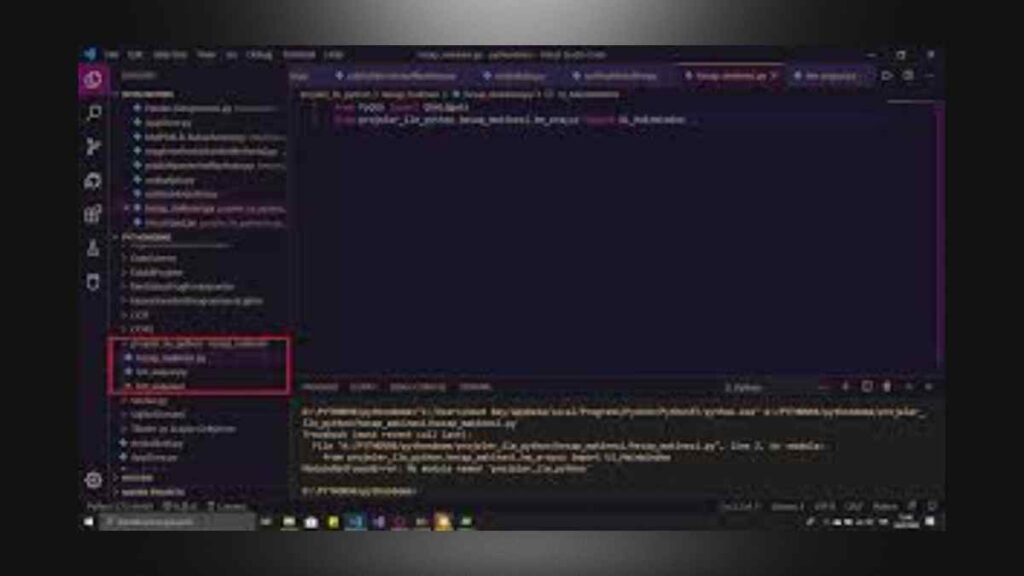ModuleNotFoundError: No Module Named ‘json_repair’ – How to Fix This Error

modulenotfounderror no module named 'json_repair'
Getting a ModuleNotFoundError Error can be annoying, especially when such an error message comes when you are writing code. The error reads: “No module named ‘json_repair'” and it leaves most developers in a daze. It is like trying to solve the most difficult part of the puzzle and just about to do it only to meet with a brickskull.
Looking for a place to start? Don’t panic! Well, this guide is here to explain in detail the probable reasons for this annoying error and the measures that can be taken to correct it. Whether you are an expert in programming or are just beginner, knowing how to address this problem will save you a lot of time and worry. Let’s enter the land of python modules and get moving on!
Explanation of the ModuleNotFoundError
ModuleNotFoundError is common in Python and alerts the user that the interpreter is unable to locate a module that has been called. This error usually happens when one attempts to import some library that is not available in the available libraries in the present environment.
When you write `import json_repair’ this means you are extending your logic to potential building blocks stored in your accessed resources, python does internal checking for the existence of the module. If the module is not found in any of the paths, then interpreter issues out a ModuleNotFoundError.
This can occur for a variety of reasons — for instance, maybe the module is not actually present even if this directive is present or you are running inside a separate virtual environment which does not contain this module.
Grasping the inherent nature of the issue at hand is very useful since it helps you figure out what exactly is going wrong with the code configuration. Once that is done, you will also know how to solve the problem of why Python is unable to find the module you want.
Possible Causes of the Error
While working on a Python project, one may encounter the error ModuleNotFoundError: No module named ‘json_repair’. This can be annoying. It is however commendable to understand when this error happens.
This one is relatively simple – the particular module is just missing in your present Python installation. Developers usually move on to different projects and therefore run out of the dependencies.
Another minor but also a pertinent cause has to do with versions. Certain modules are only suitable for a particular version of Python and using the wrong version would cause this type of error.
Errors in spelling words or using a word at the wrong context also evoked this problem. While the name may be correct, it may be misspelled, or improperly structured hence preventing Python from finding it.
At times, it is possible that a virtual environment restricts the access of globally-installed core modules. Such segregation implies that it is important to make sure that all of the required features are placed in the appropriate environment.
In sum, these factors below are partial reasons of the annoying error message that everyone encounters basically.
Troubleshooting Steps
When the error ModuleNotFoundError appears, it is vital to identify the cause of the error. First, determine whether the module is installed at all. You can do this by using pip for your packages and checking whether ‘json_repair’ would appear in the appropriate place.
Thereafter, make sure there are no mistakes in your import statement. Let’s specify them again. Often it is a small typo that easily leads to this most upsetting error.
If nothing seems to be wrong but still you have that construction error, you may want to try and remove the module and install it again. In the case of installations sometimes they can remain unfinished or become corrupted.
These steps should not be disregarded because they are important in regards to fixing Python’s common errors. Remember that every aspect is important when you are trying to fix software issues such as this one.
Step 1: Verify if the Module is Installed
‘json_repair’ has its name in the error that one would want to resolve user thirty two. However, the most sensible step to solving this kind of error is verifying that the user has the module on his or her computer. This might look very easy, however, it is an essential step in the elimination of troubles.
You may also confirm it’s installation by use of pip from your command line or terminal. All you need to do is type pip list and press the enter key. This will show you all the packages that are present on the python environment that you are currently running.
Scroll down the list, searching for the words ‘json_repair’. If you don’t see it, then it is an obvious sign that it needs to be installed.
In case you are working with the help of virtual environments, make sure you are activated inside the correct one before doing any command. Most of the time, this is because one does persist in possessing several environments.
Confirming installations is quite necessary so that one does not go through any more unnecessary moves later and is rather efficient in development.
Step 2: Check for Typos or Spelling Errors
You have got the ModuleNotFoundError, it is time to check your code for typos or spelling mistakes. Even a little mishap can translate to a lot of avoidable stress.
Now, peep the name of the module into any form that you require. Is it in the right case? Quite obviously, Python is case-insensitive such that Json_repair and json_repair are not the same words, but rather two separate words. Even a single misplaced underscore can cause problems.
Usually, there is another issue that occurs with the way you import external modules into your script. Make sure that you are following the expected syntax in any other part of your code.
Import statements are also prone to logical errors and thus those paths should be checked too. A single common mistake too far from the code can take you to a series of errors that will be hard to go back and find the source.
Leisurely looking over these specifics can do you a lot of good in terms of misery in the course of searching for the bugs that may have been caused.
Step 3: Try Installing the Module Again
If after checking you conclude that the module is not yet installed, then you have to go back and try to install it. Installation processes sometimes have their fair share of problems like, network instability, memory loss or even halting for some time.
Fire up your terminal and issue the installation command all over the again. Ensure that you’re using the correct package manager for your environment – most likely it is pip for python packages.
Check it once again before clicking the enter button if there are any version limitations mentioned by you. This may further help to deal with dependencies between packages one is trying to incorporate into a similar project.
Follow the same procedure and take note of error messages that might pop up, while installing the program after running the command. They usually give some insight on the causes of the previous errors. Assuming all was performed well, a success message should count down and indicates that ‘json_repair’ has been added.
When you are done, do not forget to shut down and launch your development environment or reload the script executed in you previous testing. This is to ensure that all these modifications will take effect right away.
Alternative Solutions
In case you still get a ‘ModuleNotFoundError’ issue, you can try again by getting a different version of python. It happens that certain modules do not go well with particular releases of python, while some do. You can get rid of such situations by simply trying your accessment code with a different release.
Another choice is to find and install the missing module manually. To begin with, look for the official repository or GitHub page for the json_repair module. Please, pay close attention to the installation instructions given there. This way you will make sure that you are receiving the most appropriate version for your configuration.
Furthermore, virtual environments can be used to prevent such errors from occurring in future projects, by preventing external dependencies. This is particularly useful if the dependencies require specific versions of other libraries, tools such as venv or conda enable,” you create in a systematic manner to install the required packages for the project.
Do not forget to pay attention to the community websites as well; one of the developers could have come up with the solution for your problem.
Solution 1: Use a Different Python Version
At times, the version of Python that you are using might be too old to support some modules. If you get an error such as ModuleNotFoundError: No module named “json_repair”, try using a different version of Python.
Confirm the present version by typing this simple command in your terminal python –version. There are certain libraries which tend to work best for one version while some will have problems with compatibility.
In that case, find and download a different version from the Python official website. It is easy to think that using the latest version normally resolves your dependencies as it does with most packages.
Once the program has been installed, it is advisable to set up a virtual environment in order to experiment without interfering with any of the other projects on your computer. In this way, you can easily change versions when you need to without any headache.
Solution 2: Manually Install the Missing Module
In the case the user came across a ModuleNotFoundError showing ‘json_repair’ Error Module could be an easy proposition. First begin by opening your terminal / command prompt.
Pip is the installer for packages in Python. All you need to do is put pip install json-repair. This command starts the process of downloading and installing the package from PyPI which is the official database of packages for Python.
Make sure that you are in the right environment that contains the location of your project. It may be required to activate the virtual environment so as to prevent any interference with other already installed modules.
After running the command try to see if you get any errors during the installation, When you have successfully resolved the installation then proceed to import ‘json_repair’ in your code.’
So make sure to re-verify the compatibility of a module with the current version of Python you are using as well.
Prevention Tips to Avoid This Error
You also manage to note a clean environment in the projects such that danger of encountering the ‘ModuleNotFoundError’ is eliminated. You need to utilize the concept of virtual environments for every python project that you are dowing using pip. This way different dependencies are kept separated and ease use of more than one version of the module within one project.
Make it a habit to ensure that your package management than just the code is updated on a regular basis: pip, conda etc. This will ensure that all the modules you use are up to date and that certain problems you already know have been solved.
Moreover, it is important to keep a complete and accurate account of all package installations made in each project. In scenarios where new environments are populated, or other persons worked on the project, a requirements.txt file, provides useful information.
Look out for common and popular libraries that related to your work. Understanding which modules are required will not only ease your work during development but also reduce the chances of installing unnecessary modules.
Conclusion
It is very exasperating to encounter a ModuleNotFoundError, particularly if one has an ongoing project. Then it is important to learn how best to deal with the error and its causes.
Most of the time, reasonable steps to resolve the problem yield good results. The use of problem diagnostics assists in identifying patterns; looking for installations and correcting errors in spelling helps in resolving the issues.
Other ways may also work out and for a good reason. Changing the version of Python or even going as far as installing the modules manually can save time.
Looking at the measures to prevent future will limit the reoccurrence of such situations. A lot of maintenance in an environment and managing dependencies will go a long way towards aiding this.
These tactics do not only solve existing problems, but they also make the coding process even more gratifying. With the right attitude, even these kinds of errors will be treated with the confidence that they will be mere speed bumps as one strides forward towards being a more savvy developer.
FAQs
What is ModuleNotFoundError?
ModuleNotFoundError is a common error in Python indicating that the interpreter cannot find a specified module. This typically happens when the module isn’t installed or has been incorrectly referenced in your code.
How can I check if ‘json_repair’ is installed?
You can verify if ‘json_repair’ is installed by running `pip list` in your terminal or command prompt. If it’s not listed, you’ll need to install it.
What should I do if reinstalling doesn’t work?
If reinstalling doesn’t resolve the error, ensure you’re using the correct environment where Python and its packages are managed properly—using virtual environments can help mitigate such issues.
Is there an alternative library for JSON repair tasks?
Yes! You might consider libraries like `jsonschema` or writing custom functions using built-in modules like `json`. They may provide robust solutions depending on your specific needs.
Can this error occur with other modules too?
Absolutely. The ModuleNotFoundError can occur with any Python module that’s either missing, misspelled, or incompatible with your current version of Python.





